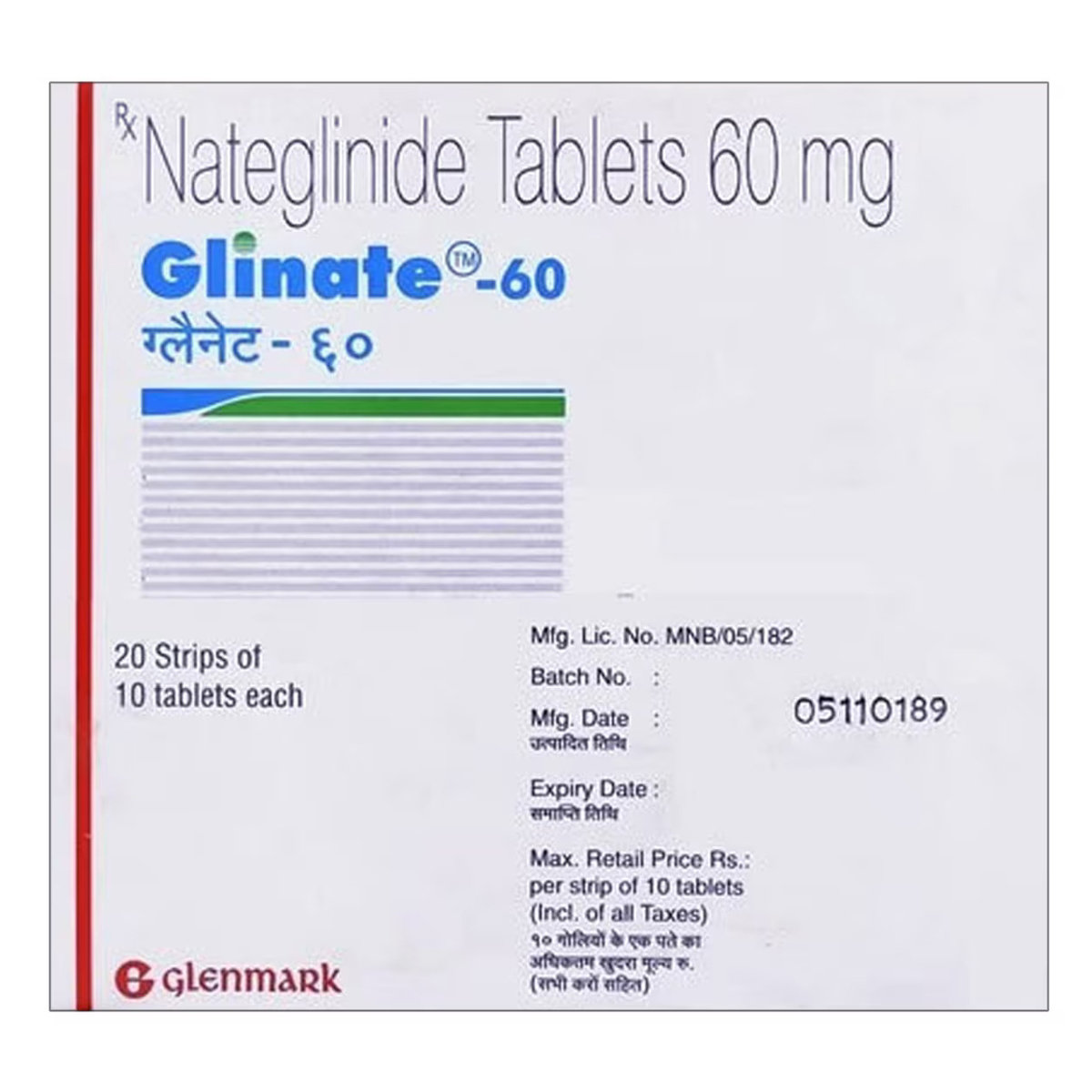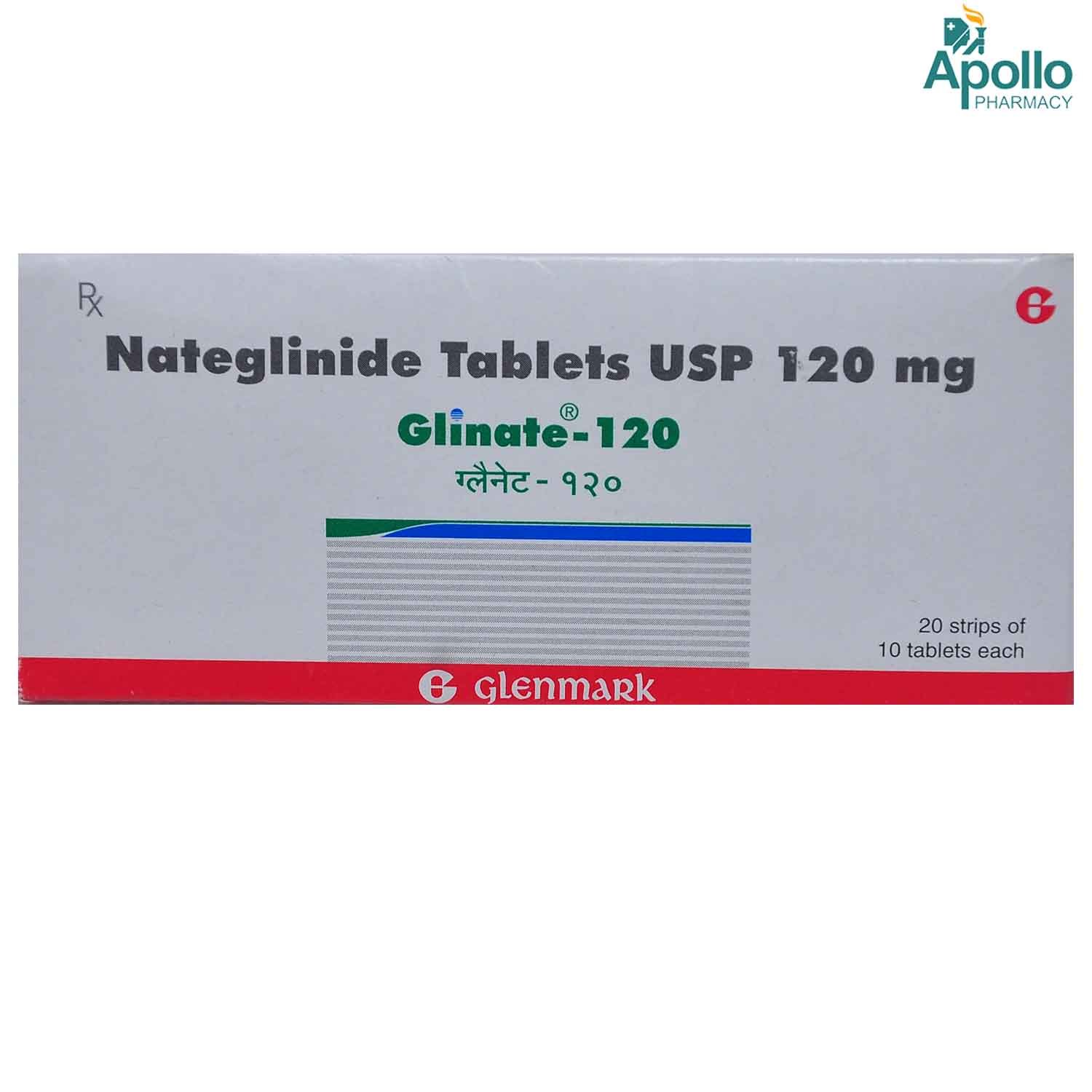Nateglinide
About Nateglinide
Nateglinide belongs to the class of medications called oral antidiabetics. It is an oral hypoglycaemic (lowering blood sugar) medication intended for people with type 2 diabetes; proper diet and exercise control blood sugar. It is used when diet, exercise, and weight reduction alone have not been found to control blood sugar well enough. Type 2 diabetes is a chronic or lifelong disorder affecting how our body processes glucose. People with type 2 diabetes either do not produce enough insulin or cannot perform their body functions (insulin resistance). Middle-aged or older individuals are most likely to suffer from type 2 diabetes, also known as adult-onset diabetes.
Nateglinide is prescribed alone or combined with other medications to treat type 2 diabetes. Nateglinide lowers blood glucose levels by stimulating the release of insulin from the pancreas.
Take Nateglinide as prescribed by your doctor. Take Nateglinide preferably before meals; its effect may be delayed if it is taken with or after meals. You are advised to take Nateglinide for as long as your doctor has prescribed. You may experience sweating, dizziness, shaking, hunger, tiredness, diarrhoea, and abdominal pain. One may experience these symptoms due to the lack of proper food intake or a high dose of anti-diabetic medicine. If you experience low blood sugar symptoms, eat or drink something containing sugar as advised by your doctor. Most of these side effects of Nateglinide do not require medical attention and gradually resolve over time. However, if the side effects are persistent, reach out to your doctor.
Nateglinide should not be stopped even if you feel better, without consulting your doctor as sugar levels keep changing. If you stop taking Nateglinide abruptly, it may increase your sugar levels. Nateglinide should not be taken if you have type 1 diabetes or severe kidney or liver disease. Do not take Nateglinide if you are pregnant or planning to become pregnant or if you are a breastfeeding women. It is also not recommended for use in children and adolescents (under 18 years of age). Speak to your doctor for information regarding this medicine.
Uses of Nateglinide
Medicinal Benefits
Nateglinide belongs to the class of medications called oral antidiabetics. It is an oral hypoglycaemic (lowering of blood sugar) medication intended to use in people with type 2 diabetes; proper diet and exercise to control blood sugar levels in the blood. It is used when diet, exercise, and weight reduction alone have not been found to control blood sugar well enough. Nateglinide is known to lower blood glucose levels by stimulating the release of insulin from the pancreas. Nateglinide has unique pharmacokinetic properties, and it will be absorbed rapidly and extensively from the small intestine after oral administration. It is also effective as a combination therapy with metformin for patients who require therapy to reduce both fasting and postprandial blood sugar (hyperglycemia).
Directions for Use
Storage
Side Effects of Nateglinide
- Abdominal pain
- Indigestion
- Diarrhoea
- Nausea
Drug Warnings
Nateglinide should not be taken if you are allergic to Nateglinide or any of its ingredients. Do not take Nateglinide if you are pregnant or breastfeeding women, have type 1 diabetes, or have a severe liver problem. Take Nateglinide with caution if you are over 65 years old, undernourished, or have an underactive pituitary or adrenal gland. Watch carefully if you have any signs of low blood sugar. Avoid drinking alcohol while on this medication, as it affects blood sugar levels. Inform your doctor before taking Nateglinide if you have a severe kidney/liver problem, have recently met with an accident, or have an active infection. Nateglinide is not recommended for children and adolescents (below 18 years of age). Check your blood sugar levels from time to time, as your doctor advises. Do not drive or operate heavy machinery if you have low blood sugar, as your ability to concentrate or react may be reduced in such a case.
Drug Interactions
Drug-Drug Interactions: Nateglinide interacts with a pain killer (aspirin), type 2 diabetes medication (sitagliptin, linagliptin, liraglutide), blood pressure medication (metoprolol), asthma medication (albuterol), and diuretic medication (furosemide).
Drug-Food Interactions: Limit alcohol intake since it affects blood sugar levels. Avoid fatty foods and include healthy carbohydrates in your diet.
Drug-Disease Interactions: People affected by type 1 diabetes, heart disease, low blood sugar level, liver disease and kidney disease should not take this Nateglinide.
Drug-Drug Interactions Checker List:
Safety Advice

Alcohol
cautionAlcohol may disturb the control of blood sugar level. Alcohol should not be consumed along with Nateglinide as it is known to interact and lead to unpleasant side effects.

Pregnancy
cautionPregnancy Category C: There are no adequate and well-controlled studies in pregnant women. It is unknown whether Nateglinide can cause fetal harm when administered to a pregnant woman. It should not be used in pregnant women.

Breast Feeding
cautionDo not take Nateglinide if you are breast-feeding. Not enough scientific data available for Nateglinide, hence it is best to consult a doctor.

Driving
cautionYour driving may be affected if your blood sugar levels are too high or too low. Do not drive or operate machinery if you may experience dizziness or drowsiness.

Liver
cautionNateglinide to be taken with caution, especially if you have a history of liver diseases/conditions. The dose may have to be adjusted by your doctor.

Kidney
cautionNateglinide to be taken with caution, especially if you have a history of Kidney diseases/conditions. The dose may have to be adjusted by your doctor.

Children
unsafeNateglinide is not recommended for use in children and adolescents (below 18 years of age). Safety and effectiveness have not been established in this age group.
Habit Forming
Diet & Lifestyle Advise
- Fill your half plate with starchy veggies, a quarter with proteins and a quarter with whole grains. Eat at regular intervals. Do not take a long gap between a meal or snack.
- Monitor your blood sugar level regularly, especially when there are lots of fluctuations.
- Invest in at least 150 minutes of moderate-intensity physical activity or one hour and 15 minutes of high-intensity exercise weekly.
- Replace refined carbohydrates containing whole-grain foods and increase the intake of fruits, veggies, and other fibre-enriched foods.
- Reduce saturated fat intake (or hidden fats) in food like chips, crisps, pastries, biscuits and samosas. Choose omega-3 fatty acid-containing oils for daily cooking.
- Do not take stress as it may elevate your blood sugar level. You can adopt stress management techniques like mindfulness to control stress-related blood sugar changes.
- Opt for low-fat dairy products (low-fat yoghurt, fat-free milk, cheese, etc.).
- Include foods rich in healthy carbohydrates and fibre, fruits, whole grains, and vegetables in your diet.
- Try eating food at regular intervals. Do not skip meals. Also, try not to overeat.
- Maintain a healthy weight by exercising regularly.
- Rest properly, and avoid stress by doing meditation or yoga.
Patients Concern
Disease/Condition Glossary
Type-2 diabetes mellitus: Type 2 diabetes is a chronic condition that occurs when our body becomes resistant to insulin or when the pancreas cannot make enough insulin. Insulin is the hormone that controls sugar levels in your blood. People with type 2 diabetes either do not produce sufficient insulin or cannot perform its function in the body (insulin resistance). Middle-aged or older individuals are most likely to suffer from type 2 diabetes, called adult-onset diabetes. Genetics and environmental factors seem to be contributing factors for type 2 diabetes. People with type 2 diabetes will have high blood sugar levels (hyperglycemia) in the blood. They will experience symptoms include increased thirst, frequent urination at night, slow wound healing, increased hunger, fatigue, and blurred vision. There may be weight gain in some cases, while weight loss may also be observed in rare cases. The complication associated with type 2 diabetes includes neuropathy (nerve problems), nephropathy (kidney problems), and retinopathy (damaged retina of eyes or blindness), sexual dysfunction and increase the chance of heart attack or stroke.
FAQs
Nateglinide works by increasing insulin production by stimulating insulin secretion from the pancrea's beta cells, thereby reducing high blood glucose (sugar) levels.
Nateglinide may sometimes lower the blood glucose levels more than normal, leading to hypoglycemia. Regularly monitor your blood sugar levels while taking Nateglinide. Hypoglycemia symptoms include headache, dizziness, drowsiness, faintness, confusion and visual disturbances.
Hypoglycaemia may occur following prolonged or severe exercise, during illness, alcohol consumption, low food intake, or when Nateglinide is taken along with other antidiabetic medicines.
Maintain a healthy diet by regular intake of carbohydrates such as bread and products containing starch and sugar. Eat your meals regularly, and do not exercise heavily for a longer duration with an empty stomach. Try to keep sugar candies. When you feel low blood sugar symptoms like excessive hunger, sweating, feeling tired, dizziness, feeling hungry, feeling shaky and fast heartbeat, immediately take it. This will increase the glucose level (sugar) in your blood, and you will feel normal.
Nateglinide is prescribed for the lifelong or chronic conditions of diabetes. So, please do not stop taking Nateglinide without consulting your doctor on your own as it may cause an increase in blood glucose levels. Continue taking Nateglinide for as long as your doctor has prescribed it to you. Do not be reluctant to speak with your doctor if you experience any difficulty while taking Nateglinide.
If you are going to have a major operation or have recently had a serious infection or illness; in such cases, diabetic control may be lost. Consult your doctor if you have any concerns regarding this; your doctor may ask you to temporarily take insulin instead of Nateglinide to control blood glucose levels.
Nateglinide might sometimes affect laboratory test results. Inform the person performing the tests that you are taking Nateglinide.
Avoid consuming alcohol while taking Nateglinide as it might increase the side-effects of Nateglinide.





